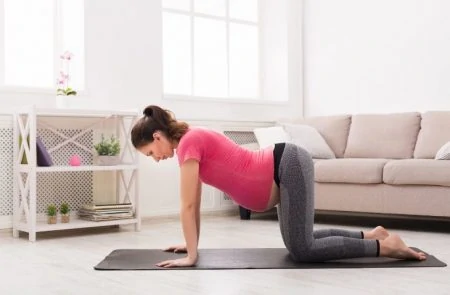Regular exercise is essential for a healthy and happy pregnancy, and stretching is a great, gentle way to do so.
Stretching works all the right muscles to help keep you feeling your best as your pregnancy progresses. Plus, you can do them while you’re watching TV or resting in bed.
We’ll discuss the benefits of stretching during pregnancy, including which stretches you should avoid, and we’ll cover some general safety tips.
We will also introduce ten simple stretches you can do throughout your pregnancy and show you how to do them correctly.
Key Takeaways
- Regular stretching throughout pregnancy has many benefits such as improved circulation, reduced insomnia and fatigue, eased muscle tension, and decreased pelvic cramps.
- Stretching prepares your body for the challenges of childbirth, helps tone and relax muscles, and aids in the recovery of organ tone and placement after birth.
- Pregnant women should avoid stomach-lying and deep twist stretches, extended back-lying postures, and extreme abdominal work to prevent injury and reduced blood flow to the uterus.
- It’s essential to consult a healthcare provider before starting any exercise program and to move slowly, use proper form, and avoid bouncing when stretching during pregnancy.
The Benefits of Stretching During Pregnancy
Regular stretching throughout your pregnancy will help you feel healthier and happier, especially as you near your baby’s birth. It will help you stay relaxed and keep you feeling comfortable in your changing body.
There are also many specific poses that you can use to help alleviate common pregnancy discomforts like backaches and hip pain.
Stretching makes you more flexible and helps tone and relax your muscles, preparing your body for the rigors of childbirth. Daily stretching aids in the recovery of organ tone and placement after birth and helps prevent prolapse of the pelvic organs.
Women who engage in stretching and other physical activity during pregnancy have also been shown to experience less pain during labor, giving them a higher chance at a natural delivery (1).
But these are just a few of the many benefits of regular stretching. Stretching during pregnancy also helps:
- Improve circulation.
- Reduce insomnia.
- Improve digestion.
- Prevent depression.
- Decrease fatigue.
- Quiet the mind.
- Ease and prevent muscle tension.
- Reduce leg and pelvic cramps.
- Ease ligament pain.
Safety Precautions When Stretching
It’s always a good idea to consult with your care provider before starting any exercise program when you’re expecting. Your doctor may have certain restrictions for you, especially if you are at risk for preterm labor or have placenta previa, high blood pressure, or were prescribed bed rest.
Here are just a few things to keep in mind when doing prenatal stretches:
- Don’t overdo it: Be sure to stop or modify a stretch if you’re uncomfortable or in pain. Don’t ever force a stretch. Listen to your body and do what feels best.
- Move slowly and gently: Your center of gravity has shifted, and your joints and ligaments are more relaxed now that you’re pregnant, so be sure to move slowly to avoid injury.
- Practice proper form: Using proper form will help you get the most out of a stretch and help prevent injury.
- Don’t bounce: Bouncing increases your chances of pulling a muscle, so gently hold your stretches instead.
- Avoid high heat or humidity: Pregnancy comes with increased blood flow and a higher metabolic rate, giving you a greater chance of becoming overheated. Therefore, it’s best to avoid exercising in hot or humid conditions while pregnant (2).
Relaxin is a pregnancy hormone that causes your joints and ligaments to loosen to support and deliver your baby. Your body continues to produce relaxin as long as you are breastfeeding. So joints will not be as stable as you are used to when you get back to more normal exercise. Keep this in mind and be gentle with yourself during pregnancy and postpartum to prevent injury.
Editor's Note:
Katelyn Holt RN, BSN, BCWhich Stretches I Should Avoid During Pregnancy?
Generally speaking, you can exercise like normal throughout the first trimester. After the first trimester, you will need to start making some adjustments, as you will become more prone to injury as your pregnancy progresses.
During your second and third trimesters, you will want to avoid the following:
- Stomach-lying postures: Steer clear of all stretches which involve lying on your stomach.
- Extended back-lying postures: Avoid stretches that require you to lie flat on your back for more than a minute or two, as this position can reduce blood flow to your uterus and can cause low blood pressure and lightheadedness. Putting a pillow under your tailbone can prevent this from happening; just avoid being completely flat for too long.
- Extreme abdominal work: As your uterus grows, your abdominal muscles will begin to separate and weaken. It’s best to avoid the boat pose and other crunch-type poses while pregnant.
- Deep twist: Avoid all poses that involve excessive twisting, as they put too much stress on your growing belly and can limit blood flow to your uterus.
You will also want to use caution with any balancing stretches, as they come with a risk of falling now that your belly is more prominent and your center of gravity has shifted. Avoid balancing poses or modify them by doing them up against a wall.
10 Stretches for a Healthy Pregnancy and Easy Labor
These ten stretches will help set you up for a healthy pregnancy and easier labor.
1. Yoga Squat
Squats are one of the best exercises for preparing for and giving birth. They strengthen your legs, open your hips and lower back, and encourage your baby to engage in your pelvis.
- Start by standing with your feet a little more than shoulder-width apart, and your toes turned out slightly.
- Keeping your knees over your toes, bend your knees, and drop your butt down toward the ground. Inhale, and slowly allow your body into a squatting position.
- Try your best to keep your heels flat on the floor.
- Bring the palms of your hands together, and place your elbows on the inside of your knees. Exhale.
- Press your hands together and press your knees open with your arms.
- Roll your shoulders back, lift your chest, and breathe comfortably.
- Hold this pose for as long as you can.
- Inhale as you return to standing.
- Repeat two to three times.
For a more gentle stretch, use a few yoga blocks to sit on while performing the squat.
This is also a pose that you can stay in to really open up your hips. Working up to three to five minutes will really strengthen you for labor.
2. Butterfly Pose
This familiar hip opener stretches your inner thighs and prepares your body for labor by strengthening your pelvic floor muscles. It also helps prevent calcification of the joints in your hips, knees, and ankles.
- Begin by sitting upright with your butt flat on the floor.
- Bend your legs at the knees, opening them to the sides and bringing the soles of your feet together.
- With a straight spine, hold on to your feet with your hands and draw your heels as close to your body as possible.
- Inhale, and gently press your knees down toward the floor.
- Exhale, and slightly bend forward while keeping your back straight.
- Hold each position for several seconds.
- Repeat the sequence up to ten times.
To increase difficulty, try bringing your feet in closer toward your body, your knees closer to the ground, and your head down toward your feet.
3. Seated Forward Bend
This stretch helps relieve tension in your lower back, opens your pelvis, and quiets the mind.
- Sitting upright on the floor, extend your legs to the sides into a wide “V.”
- As you exhale, gently lean forward and walk your palms out in front of you, bringing your stomach and chest as close to the floor as possible. Be sure to maintain a straight back while doing this.
- Hold this pose for five to ten breaths.
- Walk your palms back in toward you to gently come back up.
- Repeat two to three times.
4. Pelvic Rock (Cat-Cow)
Pelvic rocks are excellent for easing backaches, as they push the baby away from your back, giving you some relief. They also strengthen your lower back and abdominals and alleviate side and sciatic pain. This hands and knees position also helps encourage your baby to move down into the birth canal.
- Position yourself on your hands and knees with your back parallel to the ground, arms shoulder-width apart, and knees hip-width apart.
- As you exhale, gently drop your belly toward the floor and look up toward the ceiling.
- Now inhale and flip the other way, arching your back like a cat.
- Hold each position for five to ten seconds.
- Repeat this sequence 10 to 20 times.
This is a great stretch! Especially after a day of mostly sitting, try to incorporate it into your daily routine.
Caution
5. Bridge Pose
Bridge pose is another great hip opener that strengthens your abdominals, glutes, and hamstrings.
Important
- Lie flat on your back with your knees bent and feet flat on the floor.
- Drop your arms down to your sides, placing your palms flat on the ground.
- Inhale deeply, press your arms down into the floor, and slowly lift your butt off the floor while pressing your hips up toward the sky.
- With controlled breathing, hold this pose for up to 30 seconds.
- Press up on your tiptoes, inhale deeply, and slowly lower your butt back toward the ground.
- Release your heels back toward the ground.
- Repeat this sequence two to four times.
Engage your pelvic floor muscles on the inhale, release on your exhale, and this will strengthen your whole core.
6. Seated Twist
Gentle twisting poses, like the seated twist, are excellent for releasing any tension along the spine.
- Start in a seated position with your spine straight and legs crossed.
- Bring your right hand behind you and your left hand across your body onto the opposite knee.
- Inhale, and lengthen your spine.
- Exhale, and gently begin to twist your body toward your right hand, looking over your back shoulder at the wall behind you.
- Hold this position for five to ten seconds.
- Inhale, and come back to the center.
- Repeat this stretch on the opposite side.
- Repeat the entire sequence two to three times.
Twists in pregnancy should be “open,” away from your midline, not toward your midline. They should be gentle, with no overextension.
7. Side-Lying Leg Lifts
Leg lifts are always great for opening the hips and strengthening the legs.
- Lie on the ground on your left side.
- Inhale, and slowly lift your right knee, opening your hip.
- Exhale, and extend your right leg straight up toward the ceiling.
- Inhale, and bend your knee.
- Exhale, and lower your leg back down toward the ground.
- Repeat up to 20 times.
- Roll onto your right side and repeat with the opposite leg.
Optional: Gently make circles in the air with your foot.
8. Supine Frog Stretch
If you guessed that this is a great hip opener, you guessed right. The frog stretch opens your inner hips, stretches your inner thighs, and helps relieve tension in your lower back.
- Come to a supported lying position.
- Bend your knees and put the soles of your feet together.
- Allow your knees to sink towards the floor.
- In this position, relax and deep breathe, engaging and relaxing your pelvic floor.
- Hold legs open in this position for as long as you are comfortable.
9. Runner’s Lunge
The runner’s lunge is excellent for stretching your legs, opening your chest, and lengthening your spine. It strengthens your body for labor and encourages your baby to engage.
- Begin in a standing position with your feet hip-width apart.
- Exhale, and fold forward, bringing your hands down to the ground on the outer sides of your feet.
- Step your right leg back, coming down into a lunge.
- If having your hands down on the ground is too much for you, try placing your hands on your left thigh instead, or use the support of a sturdy chair or surface.
- Inhale, and sink into your front hip, making sure your knee is directly above your heel.
- Hold this position for 15 to 30 seconds.
- Step your right foot back up to meet your left foot.
- Slowly lift your chest to come back to a standing position.
- Repeat this sequence with the opposite leg.
As your pregnancy progresses, you may need to make some modifications to make room for your growing belly. You can try separating your feet wider, using yoga blocks, or bringing your back leg down on the ground and your front knee more out to the side.
10. Backward Stretch (Child’s Pose)
This pose is great for alleviating back pain, as it opens up your hips and lower back. It also helps combat nausea and fatigue and can be a great quiet time for you to bond with your baby.
- Start in a kneeling position on the floor.
- Take your knees out wide to accommodate your growing belly.
- Keeping your hips back, walk your hands out in front of you and rest your forehead on the floor.
- Stretch your arms long, and breath gently.
- Hold this position for as long as you would like.
- Walk your hands back toward you to return to a kneeling position.
FAQs
Time to Start Stretching
Now that you have ten safe poses for pregnancy, you’re ready to start stretching. These stretches will not only set you up for a healthy pregnancy but will also help tone and relax the muscles that will support you when you give birth, setting you up for an easier labor.












